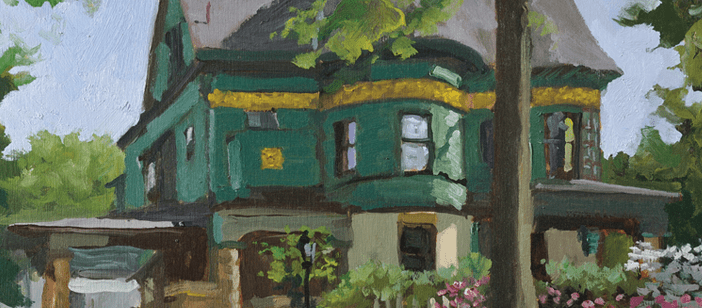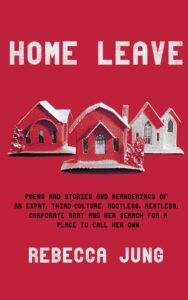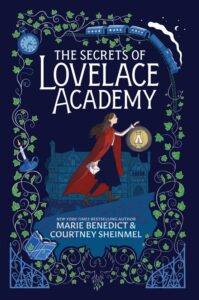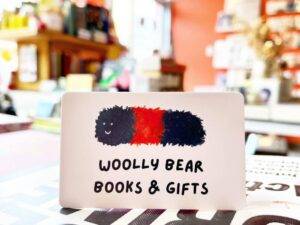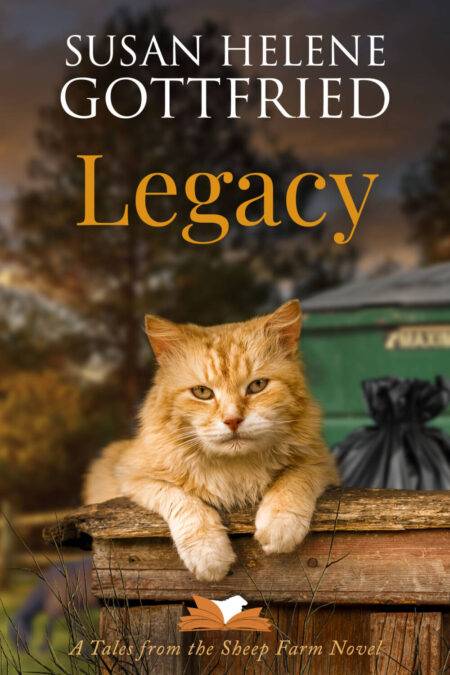The University of Pittsburgh Press announces the colorful repackaging of The Spencers of Amberson Avenue, a turn-of-the-century memoir by Ethel Spencer. The cover of the new edition features “Shadyside” by Ron Donoughe (currently housed in the permanent collection of the Heinz History Center).
“The Spencers of Amberson Avenue provides a detailed window into a time when horses pulled delivery wagons down Shadyside’s still-unpaved streets. The children’s father, who worked for Frick Coke, was a talented amateur photographer whose pictures add glimpses of what life was like for an upper-middle-class family at the turn of the last century.” —Pittsburgh Magazine
From the Publisher: “This memoir introduces the family of Charles Hart Spencer and his wife Mary Acheson: seven children born between 1884 and 1895. In a large Victorian house in Shadyside, an affluent Pittsburgh neighborhood, the family begins a middle-class way of life at the turn of the century. Mr. Spencer, who worked—not very happily—for Henry Clay Frick, was one of the growing number of middle-management employees in American industrial cities in the 1880s and 1890s. His income, which supported his family of nine, a cook, two regular nurses, and at times a wet nurse and her baby, guaranteed a comfortable life but not a luxurious one. The Spencers represent a class that ‘too often stands silent or stereotyped as we rush forward toward the greater glamour of the robber barons or their immigrant workers.’
Through the eyes of Ethel Spencer, the third daughter, the reader is led through the routine of everyday life in the Spencer household: school, play, church on Sundays, illness, family celebrations, and vacations. Ethel was an observant child, with little sentimentality, and she wrote her memoir in later life as a professor of English at Carnegie Tech, now Carnegie Mellon University. The Spencers of Amberson Avenue offers a compelling account of middle-class Pittsburgh urban life. The book is richly illustrated with family photographs taken by Charles Spencer, who was a talented amateur photographer.”
Our House
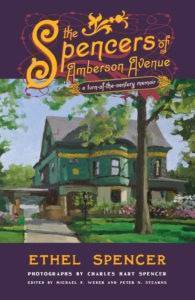 The rooms on the third floor opened off a square hall of considerable size. Its most important piece of furniture in the later years was a tall chest of drawers known as the mausoleum. During our childhood it stood in the bay window of the room adjoining Father and Mother’s, an object of great interest to all the children because Father’s pistol resided in the next-to-top drawer. Though we were allowed to look at it, we viewed its resting place with feelings of pleasurable terror. By the time Mary had finished college, however, the pistol had lost its fascination and she banished the mausoleum to the third floor. There it continued to be an object of interest because it was the repository of the family silver. Below the pistol drawer a broad panel let down until a chain inside stopped it at desk level, but the cavern within was never used as a desk; as long as I can remember it was the storage place for the silver. In our Victorian childhood solid silver, in our house at least, was not intended for daily use. We customarily ate with plated spoons and forks and cut our meat with black-handled knives while the real silver tarnished undisturbed in the mausoleum. Mother’s solid-silver tea set, her silver knives and forks and spoons and butter plates emerged from seclusion only two or three times a year.
The rooms on the third floor opened off a square hall of considerable size. Its most important piece of furniture in the later years was a tall chest of drawers known as the mausoleum. During our childhood it stood in the bay window of the room adjoining Father and Mother’s, an object of great interest to all the children because Father’s pistol resided in the next-to-top drawer. Though we were allowed to look at it, we viewed its resting place with feelings of pleasurable terror. By the time Mary had finished college, however, the pistol had lost its fascination and she banished the mausoleum to the third floor. There it continued to be an object of interest because it was the repository of the family silver. Below the pistol drawer a broad panel let down until a chain inside stopped it at desk level, but the cavern within was never used as a desk; as long as I can remember it was the storage place for the silver. In our Victorian childhood solid silver, in our house at least, was not intended for daily use. We customarily ate with plated spoons and forks and cut our meat with black-handled knives while the real silver tarnished undisturbed in the mausoleum. Mother’s solid-silver tea set, her silver knives and forks and spoons and butter plates emerged from seclusion only two or three times a year.
In summer when we went away Mother always hid these treasures in what she regarded as unlikely spots—knives between mattress and bed springs, forks in the blanket chest, butter knives in the camphor closet, spoons in the soup tureen of her wedding china, which moldered, unused like the silver, in the cupboards of the vast sideboard in the dining room. In later days when our silver was in daily use she always had difficulty in remembering where she had hidden it, and we would eat with kitchen cutlery until she had time to make an all-out search. Once she hid some treasures so effectively that we thought thieves must really have carried them off, but two or three years later during a thorough house-cleaning of the storeroom they turned up in a drawer full of skates.
The only really remarkable thing about the kitchen of 719 was the food produced in it: steaks of incredible thickness and juiciness, for breakfast as well as for dinner in our early years; a whole school of jack salmon, crisp and succulent, on Sunday mornings; coffee ground in the kind of grinder one now pays a high price for in antique shops; ice cream made of real cream and ground in a tall tin can set in a wooden bucket and surrounded with ice and salt—how we loved to lick the dasher when it was removed! Of all the good food that came out of the kitchen, bread was the best. We baked twice a week, five or six big loaves at a time. Before the days of yeast cakes the children were sent to a house on the corner of Fifth Avenue and Lilac Street to fetch yeast, which we carried home in a small bucket. Bread making was a ritual. Something mysterious was done with yeast and flour at night, and then in a big tin bread bowl the mixture sat on the warm dining-room register all night wrapped in a red blanket. In the morning there were several kneadings and risings before the dough was put into pans for the final rise. When the pans went into the oven and the bread began to bake, the house was filled with a delectable fragrance. Only the taste of the crisp brown crusts themselves, thickly spread with good butter, was better than that lovely smell. There was a ritual too about the making of buckwheat cakes. They were also mixed at night, wrapped in the red blanket, and left on the register. Cooked for breakfast the next morning, those buckwheat cakes were like nothing that a generation brought up on packaged griddle cakes has ever tasted.
The only sad memory of the kitchen is of the disappointing emptiness of the sponge-cake bowl when Mother had finished scraping the last bit of the smooth pale-yellow mixture into the pan. No woman ever had greater mastery of the spatula! This uncanny skill in scraping a bowl so clean that it hardly needed to be washed her children were prone to forget, and when the moment came for licking they always felt cheated. But the cake itself was no disappointment; Mother’s care in making it precluded failure. I can still see her weighing the eggs, changing a small egg for a larger one, taking one off the scales and putting another on until the measurement was exactly right; weighing the sugar and flour; squeezing the lemon juice and pouring it into the bowl; grating off some of the rind; tasting the batter critically and perhaps adding a little more lemon juice; whipping the whites of eggs until they were stiff and dry and then folding them gently into the yolks and sugar; and finally pouring the delectably smooth, pale yellow batter into the copper Turk’s head pan that had belonged to her German great-grandfather. For some reason, Mother was inclined to leave in the mixing bowl more of every kind of batter than sponge cake batter. Perhaps the sponge cake bowls only seemed emptier than cookie and layer-cake bowls because sponge cake, even raw, was so good.
The food that was cooked in our kitchen came chiefly from four places: dry groceries from Stevenson’s, meat from some independent butcher, vegetables and fruit from Page’s, and butter, eggs, chicken, and vegetables in season from the country market in town. Stevenson’s telephoned for our order every week, but the butcher got his by word of mouth daily. Howard, the driver for Eckert and Fry with whom Mother dealt for many years, would stand at the foot of the back stairs, and Mother, standing by the gate that kept her children from falling down the stairs, would tell him what to bring tomorrow: steaks, roast beefs, roasts of lamb, lamb chops-in those good old days meat was cheap and meat orders were generous.
Mother began to buy vegetables from Mr. Page early in her married life. When memory began for me, his shop was a wagon with a big bunch of bananas hanging at the end that came daily to our door. It was not long, however, before he had a store on Aiken Avenue near enough to be within easy reach. When something had been forgotten, one of the children was sent there to fetch it in a hurry. When the bill was to be paid, we clamored for the privilege of acting as messenger, for Mr. Page always gave us a present with the receipt. Once he gave me a whole box of apricots, and Betts remembers with pleasure boxes of Four O’clock Teas. Mother always said that everything one bought from Tom Page was good and that he gave good measure. She dealt with him until his prices rose so high that she could no longer afford to patronize him, but she left him with regret.
Our butter and chickens and eggs generally came from the Pittsburgh market, which Mother visited every Saturday morning till the last year of her life. The buying of butter was an art. I can still see Mother going about from country woman to country woman, eyeing their rolls of butter critically, taking up an end of the paper in which a roll was wrapped, nipping off with it a bit of butter, tasting it appraisingly with rapid smacking of the lips, and as a rule rejecting it. A country woman with a good pound of butter one week was just as likely as not to bring in a bad one the next week, so the tasting ritual had to be gone through with every Saturday. The buying of chickens was just as ritualistic, though here it was a question of the breast bone. If the end of that bone was still flexible, the chicken was young, but it had to be fat as well as youthful, and shapely. From the country market Mother brought home other treasures—the first garden peas of the season, delicious as peas have never been since they have been obtainable all the year round; boxes of shelled lima beans, tiny and succulent; fresh com; delicious little squabs for a child recuperating from illness. In the spring she occasionally brought bunches of delicate hepaticas or trailing arbutus or trillium. The butcher usually brought her marketing home when he delivered the meat, but she often came staggering back with her arms full of good things.
The food that came from market and Page’s and the butcher’s was kept in the cellar under the dining room. Baskets of vegetables and fruit sat on a long bench against one wall, and the big double-doored ice box against the opposite wall held the more perishable things. Beyond a door beside the ice box other supplies were kept. A partition had been put up in that cellar during our childhood when crowding in the attic had become acute, with the intention of using the inner section as a storeroom. It was never so used, however, because it proved to be damp, and it promptly became a second food cellar. Bushels and bushels of potatoes were stored there, for we were oblivious to more recent dietary notions and happily ate potatoes every night for dinner. A barrel of apples always stood near the mountainous pile of potatoes, usually Northern Spies or Kings, which we were allowed to raid every day after school. No apples have ever tasted so good since as the crisp, tart, juicy apples from those barrels.
In the front food cellar there was a big closet in which preserved food was kept. On its shelves sat glasses of blackberry, grape, peach, black raspberry, and currant jelly and jars of peach butter, whole peaches, plums, and tomatoes. During the summer the children were called upon to help preserve these delicacies. We pulled grapes and currants from their stems, removed skins from tomatoes and peaches, and stirred peach butter endlessly with a long wooden stirrer. These tasks were rather boring, but we all liked to see the shelves of the fruit closet full.
Excerpted from The Spencers of Amberson Avenue by Ethel Spencer. Published by University of Pittsburgh Press, Copyright © 1983. All rights reserved. No part of this excerpt may be reproduced or reprinted without permission in writing from the publisher.


